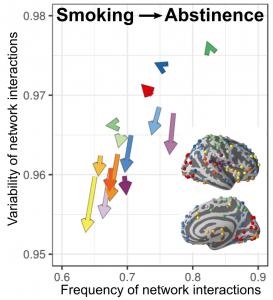
Smoking withdrawal leads to both whole-brain and network-specific decreases in brain dynamics.
Featured Paper of the Month – April 2021
Published in Biological Psychiatry: Cognitive Neuroscience and Neuroimaging by John Fedota, Ph.D. and Thomas Ross, Ph.D., et al. in the NIDA IRP Cognitive and Affective Neuroscience of Addiction Section.
Summary
Quitting smoking is hard. This is largely due to the nicotine withdrawal syndrome. Withdrawal from cigarettes is characterized by craving, bad feelings and losses of attention. Importantly, these negative symptoms are known to fluctuate wildly in time. Inspired by this, NIDA scientists applied a technique that allowed us to look at how communication across the entire brain fluctuated over time during smoking and withdrawal. Twenty-five smokers came to NIDA twice each. During the first visit they smoked a cigarette and were not in withdrawal. Before the second visit, they did not smoke for 2 days and so were in peak withdrawal. At each visit they underwent a function magnetic resonance imaging (MRI) scan. This scan measures brain activity. NIDA scientists analyzed these data to examine which brain regions were varying together and how that changed over the duration of the scan. They found that nicotine withdrawal led to brain-wide decreases in the frequency of interactions between brain networks. In addition, within a subset of these networks, the variability of these interactions also decreased. Finally, within 2 of these networks, the decrease in variability was related to withdrawal symptoms. So, withdrawal leads to decrease in brain dynamics, and this may be part of why quitting is so hard.
Publication Information
Time-Varying Functional Connectivity Decreases as a Function of Acute Nicotine Abstinence Journal Article
In: Biological Psychiatry: Cognitive Neuroscience and Neuroimaging, 2020, ISSN: 2451-9022.
